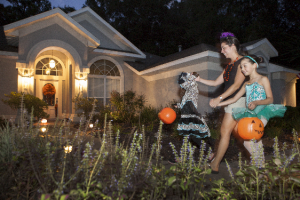As daylight saving time draws to an end, days get shorter, and the heat of summer finally begins to fade, the end of October is a time for ghoulish festivities and – perhaps surprisingly – energy savings! Read on for some quick and easy behavior changes that will reduce your ecological footprint and help you save up for next year’s Halloween costumes.
Energy Vampires
These little bloodsuckers are silently draining your wallet! Leaving cell phone chargers, laptops, printers, and coffee makers plugged in allows them to continue drawing energy and running up the electric bill. A good signal that something is an energy vampire is if it has a light to tell you that it’s off. If you often forget to pull the plug, smart power strips can be a great alternative. These strips cut power to accessory devices when you turn off a main device. Good uses for these include a computer (main device) and printer or a television and a DVD player, DVR, or extra speakers.
More Practical than Jack-o’-Lanterns

Lighting your home and landscape is often the first line for energy savings. And while candles don’t use any electricity, they are less than practical (and a fire hazard!). A much better alternative to save money on lighting is to replace your lightbulbs with CFLs or LEDs. Outdoor LEDs are available in a variety of styles, including icicles and cascade tubes to spice up a holiday landscape without breaking the bank. To compare, CFLs are less energy efficient than LEDs, but are cheaper. LEDs have the additional advantages of not containing mercury and more models being usable in dimmable fixtures.
Avoid Spine-Chilling Settings
A final quick tip to save energy this fall is to look at your thermostat settings. While the weather is still warm, keeping the temperature set at 78° F and utilizing ceiling fans to keep cool is a great strategy. For every degree above 72° F you save 5% on cooling costs. But as temperatures take a dive lower your thermostat setting to 68° F and pull on a blanket. Another option is to use natural ventilation when outdoor humidity falls below 70% – just be sure to turn the A/C off before opening the doors and windows to enjoy the autumn air and turn it back on after you close up.
Additional Resources:
http://livinggreen.ifas.ufl.edu/energy/heating_and_cooling.html
http://edis.ifas.ufl.edu/fy1026
http://edis.ifas.ufl.edu/fy1044
http://edis.ifas.ufl.edu/fy1031
 0
0
